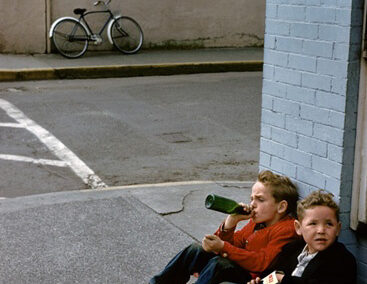Our next Artist You Need To Know is Fred Herzog (1930 – 2019).
Fred Herzog’s artistic practice was an extension of his walking the streets of Vancouver (and almost forty other countries) with his Leica camera. Using colour slide film almost exclusively, Herzog documented the lively streets and sites of street life in all its complexities and commotion. He was “celebrated internationally for his pioneering street photography, his understanding of the medium combined with, as he put it, “how you see and how you think” created the right moment to take a picture. (from here)
“The thing that street photographers hope to discover has to do with the disorderly vitality of the street; the street people on the corners and plazas, in billiard parlours, pubs and stores, where shoppers, voyeurs and loiterers feel at home.” (from here)
Ulrich (Fred) Herzog was born and lived his early life in Germany : after his parents died during WW II he lived with his aunt and uncle. Herzog inherited from his uncle a large folding plate camera which he would then upgrade to a more manageable Kodak Retina and began to teach himself photography by documenting his friends and their activities.
Like many, he emigrated to Canada (in 1952) seeking a new life and new opportunities. Herzog settled in Vancouver in 1953 and over the following years worked on ships for the CPR steamship line while studying photography magazines. The beginning of his career in photography can be marked from 1957 when he was hired as a medical photographer at St. Paul’s Hospital. Later, in 1961, he became the head of the Photo / Cine Division in the Department of Biomedical Communications at UBC, and in 1970 was appointed Associate Director of the Department. Herzog was also a teacher in the Fine Arts Department at Simon Fraser University and later became an instructor in the Fine Arts Department at UBC.
“Herzog had a walking route through Vancouver that enabled him to build friendships with other photographers and neighbourhood residents and gave him an acute understanding of the daily life and soul of Vancouver. Over the course of several decades, Herzog produced a substantial body of colour photographs, taking urban life, second-hand shops, vacant lots, neon signage and the crowds of people who have populated city streets over the past years as his primary subjects. Herzog’s use of colour was unusual in the 1950s and 60s, a time when fine art photography was almost exclusively associated with black and white imagery [Herzog is credited with being an inspiration to the New Colour photographers of the 1970s]. Additionally, Herzog photographed using Kodachrome slide film that was notoriously difficult to print. For decades he remained virtually unknown until his mid-seventies when printing technology caught up, allowing him to make archival pigment prints that matched the exceptional colour and intensity of the Kodachrome film.” (from here)
Herzog was often compared to Saul Leiter (“another flaneur with a camera” to cite Herzog’s obituary in The Guardian) who was a contemporary of the artist.
A retrospective exhibition, Fred Herzog: Vancouver Photographs, was held at the Vancouver Art Gallery in 2007 and was the first major recognition of Herzog’s photography. He exhibited his work both in Canada and internationally, including the exhibitions Fred Herzog: Photographs, C/O Berlin, Germany (2010), Fred Herzog: A Retrospective, Equinox Gallery, Vancouver (2012), Eyes Wide Open! 100 Years of Leica Photography, Haus der Photographie, Hamburg, Germany (2015), Photography in Canada, 1960-2000, National Gallery of Canada, Ottawa (2017), and many others.
“The Vancouver photographs of Fred Herzog are awash with vibrant color. They are complex, mysterious, exuberant, and full of life, much like the city he photographed.” (from Laurence Miller Gallery)
Herzog was awarded a Honorary Doctorate from Emily Carr University of Art and Design (2010), and was awarded the Audain Prize for Lifetime Achievement in the Visual Arts in 2014. Also in 2014, his photograph Bogner’s Grocery (taken in 1960) was released as a limited edition stamp as part of Canada Post’s Canadian Photography Series.
“Take street pictures because it hones your instincts for speed and for quick composition. But above all what you bring in your mind to the scene is what makes your picture. If you don’t read, if you don’t have discussions with enlightened friends, you do not get there. There is a saying about seeing : Only a few people can see but most people don’t even look. And that says a lot to me. You can only see if you have something in your mind to bring to the picture. The camera is the least important adjunct to your ideas. Your observations are important because they’re you. The camera is just a gadget you can carry in your hand or around your neck or on a tripod.”
Herzog passed away in 2019 at the age of 88. Much more of his work can be seen here at Equinox Gallery and here at Laurence Miller Gallery. An obituary about Herzog can be read here that speaks of how Herzog “was more of an instinctive observer, both detached from, and immersed in, the small human dramas of the city he documented with a painterly eye for stillness, light and, above all, colour.”



























